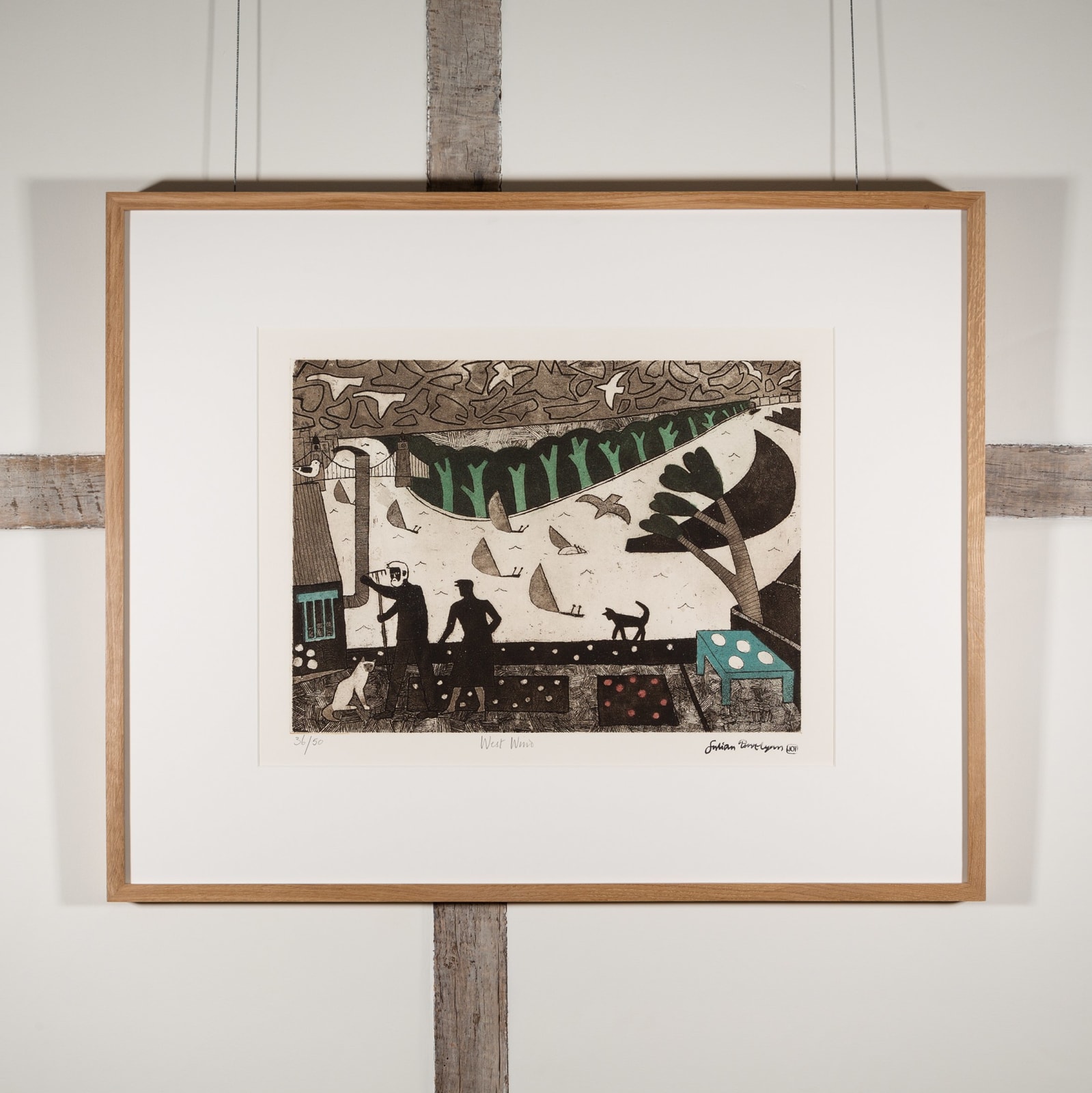Julian Trevelyan 1910-1988
West Wind, 1983
etching and aquatint
56 x 76 cm
22 x 29 7/8 in
22 x 29 7/8 in
with Estate stamp, numbered and titled by Mary Fedden in pencil, edition of 50 + 5 AP
Currency:
‘Here … I put down my tap-root; My life was measured by its tides, and my dreams were peopled by its swans and seagulls. It has become the backcloth to...
‘Here … I put down my tap-root; My life was measured by its tides, and my dreams were peopled by its swans and seagulls. It has become the backcloth to all my various activities and has remained so ever since’ (Julian Trevelyan, Indigo Days, Macgibbon and Kee, London, 1957, p.50).
Trevelyan and his first wife, the well-known British potter Ursula Mommens, found Durham Wharf on the first day of their search for a property to live, having married in 1934. Whilst walking by the river in Hammersmith, they discovered a 'To Let' sign on some old buildings by the river and immediately fell for the location: 'The tide was up and gulls flew screaming round us while tugs and sailing dinghies slapped about in the choppy water; we realised instinctively this was our home and we could live nowhere else' (Julian Trevelyan, Indigo Days, Macgibbon & Kee, London, 1957, p.49). They took the lease the same day and Ben Nicholson's brother, Kit, converted the buildings into a studio and residence with a shed for Ursula's oil fired kiln. Facilities were pretty basic and the couple lived close to the elements with only an old 'Pither' stove for heating:
'On winter nights, the westerly gales would hurl themselves at the tin roof which would quiver like thunder, and it was difficult to believe that one was not on the edge of the Atlantic' (Julian Trevelyan, ibid., p.50).
Trevelyan settled down to domestic life and his work thrived during this period particularly through the series of paintings in the 1940s which celebrated his life at the Wharf. Philip Trevelyan notes: 'it was at Durham Wharf that the complexity of his ideas and the different strands in his vision would come together: the brilliant light of these riverside studios would re-open his ideas' (Philip Trevelyan, Julian Trevelyan: Picture Language, Lund Humphries, Farnham, 2013, p.97). Julian Trevelyan wrote at the time: 'Now, within a year of my arrival in London, I found myself in a very different climate. Night had given way to day, a blustery spring day perhaps, but I accepted it as a way out of the impasse into which I had got myself.' (Julian Trevelyan, 'Indigo Days', Macgibbon and Kee, London, 1957, p.47).
Trevelyan and his first wife, the well-known British potter Ursula Mommens, found Durham Wharf on the first day of their search for a property to live, having married in 1934. Whilst walking by the river in Hammersmith, they discovered a 'To Let' sign on some old buildings by the river and immediately fell for the location: 'The tide was up and gulls flew screaming round us while tugs and sailing dinghies slapped about in the choppy water; we realised instinctively this was our home and we could live nowhere else' (Julian Trevelyan, Indigo Days, Macgibbon & Kee, London, 1957, p.49). They took the lease the same day and Ben Nicholson's brother, Kit, converted the buildings into a studio and residence with a shed for Ursula's oil fired kiln. Facilities were pretty basic and the couple lived close to the elements with only an old 'Pither' stove for heating:
'On winter nights, the westerly gales would hurl themselves at the tin roof which would quiver like thunder, and it was difficult to believe that one was not on the edge of the Atlantic' (Julian Trevelyan, ibid., p.50).
Trevelyan settled down to domestic life and his work thrived during this period particularly through the series of paintings in the 1940s which celebrated his life at the Wharf. Philip Trevelyan notes: 'it was at Durham Wharf that the complexity of his ideas and the different strands in his vision would come together: the brilliant light of these riverside studios would re-open his ideas' (Philip Trevelyan, Julian Trevelyan: Picture Language, Lund Humphries, Farnham, 2013, p.97). Julian Trevelyan wrote at the time: 'Now, within a year of my arrival in London, I found myself in a very different climate. Night had given way to day, a blustery spring day perhaps, but I accepted it as a way out of the impasse into which I had got myself.' (Julian Trevelyan, 'Indigo Days', Macgibbon and Kee, London, 1957, p.47).



